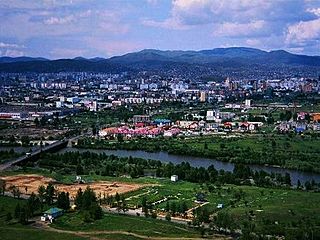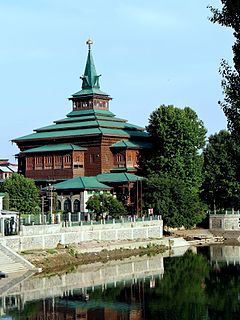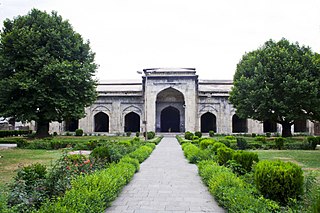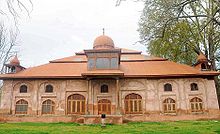
Situated at the center of the Kashmir valley, Srinagar is the second most populous district in the Indian state of Jammu and Kashmir, after Jammu District and is home to the summer capital (Srinagar) of Jammu and Kashmir. The largest city is Srinagar.

Nowhatta or Nohatta is a town of historical importance situated at a distance of 5 km from Srinagar in Jammu & Kashmir. Nowhatta is famous because of Historical Mosque known as Jamma Masjid. Nowhatta area has eighteen sub-communities Mohalla. The place is also notable for high rate of stone pelting incidents in Kashmir. Each week after Friday prayers, people stage their protest against Indian rule which most of the times results in stone pelting incidents in the area.
A jama masjid, also known as a congregational mosque or Friday mosque, is a type of mosque which is the main mosque of a certain area that hosts the special Friday noon prayers known as jumu'ah. They also host the Eid prayers in situations when there is no musalla or eidgah available or nearby to host the prayers.

Anantnag is a city and a municipality, capital of the Anantnag district in the Indian state of Jammu and Kashmir. Anantnag is located at a distance of 53 kilometres from the state's capital Srinagar. It is the third largest city in Jammu and Kashmir after Srinagar and Jammu with an urban agglomerate population of more than 200,000 and municipal limit population over 100,000.

Jamia Masjid is a mosque in Srinagar, Jammu & Kashmir, India. Situated at Nowhatta in the middle of the Old City, the Mosque was commissioned by Sultan Sikandar in 1394 CE and completed in 1402 CE, at the behest of Mir Mohammad Hamadani, son of Mir Sayyid Ali Hamadani, and is regarded as one of the most important mosques in Kashmir. The architectural style of the Mosque is inspired by the Indo-Saracenic style of architecture, which is a blend of Indian and Mughal styles, and also bears similarities to Buddhist pagodas. The Mosque is located in Downtown which remains a central zone to the religio-political life in Srinagar. Thronged by Muslims every Friday, it is one of the prime tourist attractions of Srinagar.

Shopian is the hill district of Kashmir valley. Shopian has been an ancient Town of Kashmir, which among other factors has a certain historical importance since it is situated on the ancient imperial route commonly known as Mughal Road which connects Lahore & Srinagar. Currently under construction Mughal Road links District Shopian with the districts of Rajouri & Poonch.. Shopian is a historical town, and has gained importance from the time of Mughal rulers. It was previously known as 'Sheen-e-van' meaning 'forest of snow'. Shopian was one out of six Wazarat Headquarters in Kashmir from 1872-1892 A.D. Shopian has been an ancient Town of Kashmir, which among other factors in the past has historical importance, since it is situated on the ancient imperial road commonly known as Mughal Road. Shopian has the honour to had Imam Shahi Hamadan entered via it into the Kashmir valley to spread the message of Islam. The district has the privilege of having the [["Holy Relic” of Prophet Mohammad (SAW) at khankah Pinjoura.]] The first and foremost political and social activist from Shopian was Late Pt. Swaroop Nath Saraf, popularly known as "Baba-e-Shopian". Born in 1907 in Shopian, he was one of the pillars of National Conference and was among the chief comrades of Late Sheikh Abdullah and was a veteran freedom fighter, who committed his whole life for the welfare of Shopian. It was Pt. Saraf, who led the popular agitation in 1979 for giving Shopian the much-aspired District status. He established Shopian High School, which was later amalgamated with Government Higher Secondary School by Sheikh Abdullah. . The district is known as Apple Bowl of the state as it is famous for Horticulture Sector. The district possesses tremendous scope for expansion of fruit industry under different schemes which can boost the economy not only of this district but the whole state. The District with lush green forests especially in the areas like Sedow, Hirpora & Keller is rich in scenic beauty. Shopian district has many tourist attraction:the Kounsernag, Kongiwatan, Arshi Pora Lahanthour,Sedow, Herpora etc. The Jamia Masjid in Shopian is one of the famous historical monuments built during the Mughal reign resembling that of jamia masjid Srinagar. The famous Aasar-i-Sharief Dargah at Pinjura, attracts thousands of devotees on the occasion of Eid-i-Milad-un- Nabi and Shab-i-Mehraj. Darul Uloom Islamia Pinjura where large people gather to seek knowledge and propagate to others. which is one of the extremely coldest towns of Jammu and Kashmir, India.

Bemina is a region in Srinagar, the capital city of Jammu and Kashmir, India.

Bagh e Mehtab is located in Srinagar, Jammu and Kashmir, India, about 7 km away from city centre, Lal Chowk. The area is primarily a residential area with a government housing colony and private colony.

Achabal is a village in Baramulla district, Jammu and Kashmir. It is around 5 kilometers away from Sopore town. The village is surrounded by the main villages of Rafiabad like Lorihama, Alsafa Colony,ladoora and Ferozpora. This village is accessible by the National Highway from Ferozpora-Achabal link road which connects it to Handwara, Kupwara and other northern regions of Kashmir. It is also accessible by Ladoora-Sopore road. Achabal is said to be the most forward and richest village of Rafiabad. It is one of few villages in Kashmir to have J&K Bank which is stationed in BABA COMPLEX.Achabal is a famous village in District Baramulla. The first person to contest assembly elections from this village was Fayaz Ahmad Malik well known as Kakaji. He filed his nomination papers as independent candidate on 21 November 2014 for 2014 assembly elections. Fayaz Ahmad Malik lost in the assembly elections which were held on 9 December 2014 and results declared on 23 December 2014. He lost to Jammu and Kashmir Peoples Democratic Partys Yawar Ahmad Mir son of Mohamad Dilawar Mir.

Seeloo also known as "Seelu" is a small village located in baramulla District in the state of jammu and kashmir. The village is situated on the Srinagar-Kupwara national highway and is located on the banks of the Pohru River. Seeloo consists of 5 mohalla This includes Al-umar, Naikpora, Telwanpora, Bhat Mohala, and Hajam Mohalla.

Madin Sahib (Madeen Sahab or Madin Saeb Kashmiri مدین صاْب) is an old mosque located near Nowshohar, Srinagar, in Indian administered Kashmir. The other neighborhoods close to it would be Bagh-e-Ali Mardan Khan and Saz Ghar Poor. Madin Sahib Masjid was built by Sultan Zain-ul-Abideen (Budshah) in 1448. He named it after his teacher Syed Mohammad Madani, who is also buried to the left of the Masjid. Syed Mohammad Madani became Madin Saeb for Kashmiris.
Syed Madani came from Madeenah to India with Timur in 1398. He was sent to Kashmir as Timur's envoy to Sultan Sikander. Madin Sahib liked Kashmir so much that he decided to stay. He initially stayed in Rainawari after becoming a disciple of Syed Mohammad Hamadani. He later on moved close to Badshah's Capital Nowshahar, where Budshah built him the Khankhah. He died on 11 Rajab 849. Khwaja Baha-Ud-Din (Ganj-Bakhash) lead his funeral prayer. The tile work at Madin Saeb is considered one of the unique examples of this art and it is not seen anywhere else in Kashmir or Indian sub-continent for that matter.
Nadihal is a village located in the north of Jammu and Kashmir state in India. It is just 4 km away from Bandipora town, and 51 km away from Srinagar. It the largest village in Bandipora district. There are many small villages around it. It is a prosperous and modern village with a population of 5167. Nadihal is inhabited largely by Muslims. In this village there are two government middle schools, one higher secondary school, and two high schools. Besides Government run schools, there are a few private schools as well in this village The level of education in Nadihal is moderate, but has significantly increased in recent times.

Downtown, popularly known as Shehr-e-Khaas, is the largest and the most densely populated area of the city of Srinagar in Jammu and Kashmir. The area is mostly located on the banks of Jhelum river about 5 km from city center. The area is considered as the core point in the city as the first inhabitants of the Srinagar lived there.

Khanqah-e-Moula, also known as Shah-e-Hamadan Masjid and Khanqah is one of the oldest mosques in Kashmir, located in the Old City of Srinagar, Jammu and Kashmir. Situated on the right bank of the river Jhelum between the Fateh Kadal and Zaina Kadal bridges, it was first built in 1395 CE, commissioned by Sultan Sikendar. It is one of the best examples of Kashmiri wooden architecture, and is decorated with papier mache.

Khushal Sar is a lake in highly deteriorated condition, located in Srinagar, Jammu and Kashmir, India. It has been encroached upon at many places with illegal construction and landfilling. The lake once stretched from Zoonimar up to the Aali Masjid but now it is considerably reduced. It is connected to the Anchar lake via a small channel. Another smaller lake, known as Gilsar, is connected to the Khushal Sar via a narrow strait, which is spanned by a bridge known as Gil Kadal. The Gilsar lake is in turn connected to the Nigeen lake via the Nallah Amir Khan. Until the 1970s, the Mar Canal drained into this lake providing navigability up to Ganderbal via the Anchar lake. After the filling up of the Mar Canal, the condition of the lake deteriorated further.

Pathar Masjid, known locally as Naev Masheed, is a Mughal era stone mosque located in the old city of Srinagar, in the Indian state of Jammu and Kashmir. It is located on the left bank of the River Jhelum, just opposite the shrine of Khanqah-e-Moula. It was built by Mughal Empress Noor Jehan, the wife of emperor Jehangir. The mosque has some distinct features that separate it from the rest of the mosques in the Kashmir Valley. Unlike other mosques, it does not have the traditional pyramidal roof. Furthermore, the mosque has nine mehraabs (arches), with the central one being larger than the others.

Government College for Women,Nawakadal Srinagar commonly known as Women's college Nawakadal,Nowkadal College is a University Grants Commission autonomous college located in Old City Downtown Srinagar. It was established in 1961.The college is affiliated with the University of Kashmir. It is the only Women Institution in Kashmir Valley offering Commerce & management Courses.

The 2017 Nowhatta mob lynching, was the lynch mob murder and mutilation of on-duty Indian Kashmiri Muslim security official, Muhammad Ayub Pandith on the Muslim holy night of Laylat al-Qadr on Thursday 22 June 2017 by a mob after a crowd shouted slogans in favor of Pakistan as well as the al-Qaida operative and jihadist Zakir Musa. Sajjad Ahmad Gilkar, a Hizbul Mujahideen member, had played a key role in the lynching according to the state police.
















